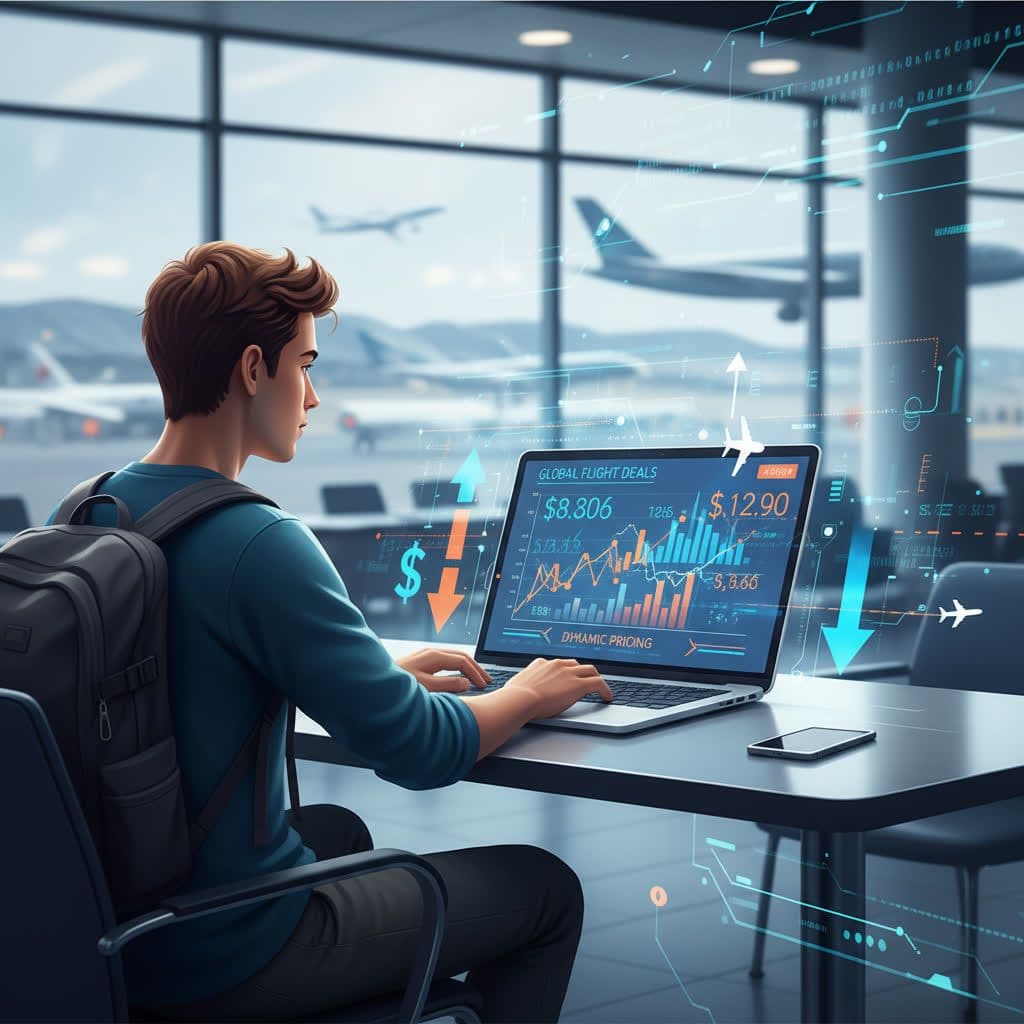Why Flight Ticket Prices Change Every Time You Search: The Truth About Airline Dynamic Pricing

The Real Story Behind Airline Dynamic Pricing: How Flight Prices Really Work
Have you ever checked a flight fare, stepped away to think about it, and returned later only to find the price had jumped by thousands of rupees? You’re not alone. It’s one of the most frustrating travel experiences — and it often raises the question: are airlines tracking your searches and raising prices?
The truth is less personal but far more fascinating. Behind every airfare change lies a complex web of data-driven algorithms, predictive analytics, and real-time pricing systems that constantly adjust fares. Let’s uncover how airline dynamic pricing actually works — and how you can use it to book smarter and save money.
Airline Pricing Is More Than Just Supply and Demand
At first glance, it might seem like flight prices rise only when demand increases. But in reality, airlines rely on data science, automation, and artificial intelligence to decide fares. Their systems continuously calculate the best price for every seat, on every route, every minute.
Here’s how airlines set prices:
- Dynamic Pricing Engines: Adjust fares moment-to-moment based on seat sales, demand, and competitor prices.
- Revenue Management Systems: Use predictive analytics to forecast demand and recommend price changes.
- Fare Classes (Inventory Buckets): Seats are divided into price tiers; once lower fares sell out, only higher-priced seats remain.
This constant recalibration helps airlines maximize revenue from each flight — making airfare one of the most dynamic products in the world.
The Cookie Myth: Are Airlines Tracking Your Searches?
A common travel myth claims that flight prices rise if you search too often or switch devices. But industry experts and travel platforms like Skyscanner, Google Flights, and Expedia have repeatedly confirmed — airlines don’t raise prices based on cookies or browsing history.
Why flight prices still change when you search again:
- Airlines update fares for everyone, not per individual user.
- Cookies store preferences, not pricing behavior.
- When seat availability changes, prices update globally.
So, whether you use incognito mode or clear your cookies, it won’t impact airfare. What you’re seeing is simply the airline’s real-time pricing algorithm in action.
Why Flight Prices Change So Often
Airfare is one of the most volatile products online. Prices can change multiple times a day due to several real-world factors.
The main drivers of airfare changes:
- Real-Time Demand: Sudden interest in a route triggers price increases.
- Seat Availability: Cheaper fare classes sell out first, pushing prices higher.
- Time to Departure: Prices rise closer to the travel date, especially for business routes.
- Competitor Pricing: Airlines monitor rivals and adjust fares within minutes.
- Market Events: Holidays, sports events, or weather can influence demand and prices.
Inside Airline Revenue Management
Selling a flight isn’t just about filling every seat — it’s about selling each seat at the right price. This is where revenue management systems come in.
These systems rely on:
- Historical Data: Past booking trends help predict demand.
- Yield Optimization: Prices are adjusted to maximize total flight revenue.
- Customer Segmentation: Business and frequent flyers may see targeted offers.
Think of it as a real-time auction, where each ticket’s price is continuously recalculated.
Common Airline Pricing Strategies
Every airline uses its own pricing model to stay competitive in the market:
- Legacy Pricing: Traditional carriers follow fixed fare structures.
- Competitor-Based Pricing: Fares are matched or slightly undercut in real time.
- Penetration Pricing: New airlines offer low introductory fares to attract passengers.
- Value-Based Pricing: Prices are based on perceived value and route popularity.
These flexible strategies help airlines balance profitability and competitiveness.
How Online Travel Agencies Display Prices
Platforms like MakeMyTrip, Expedia, and Skyscanner aggregate fares from hundreds of airlines and ticket consolidators. The prices you see might differ slightly between sites because:
- Some agencies have exclusive contracts or bulk inventory.
- Pricing systems refresh data at different intervals.
So, if fares vary, it’s usually due to data sourcing differences, not tracking.
Smart Tips to Beat Airline Dynamic Pricing
You can’t stop airlines from using dynamic pricing — but you can use strategy to your advantage.
Pro Tips for Cheaper Flights:
- Book Early: The lowest fare classes are released first.
- Stay Flexible: Adjust your travel dates or try nearby airports.
- Set Price Alerts: Use fare-tracking tools like Google Flights or Hopper.
- Avoid Last-Minute Bookings: Prices spike close to departure.
- Watch for Flash Sales: Book fast when discounts appear — they go quickly.
Final Thoughts: Search Smart, Book Confidently
Flight prices don’t rise because you searched too often — they change because airlines operate within a dynamic, data-driven pricing ecosystem. Every fare adjustment reflects real-time demand, competition, and predictive modeling.
By understanding how airline pricing works, you can book more strategically: plan ahead, stay flexible, and let data work for you instead of against you.
So next time you see a fare jump, don’t panic — it’s not personal. It’s just the algorithm doing its job.
Key Takeaways
- Airline prices change constantly due to dynamic pricing systems.
- Cookies and personal searches don’t affect fares.
- Book early and stay flexible to get the best deals.
- Fare changes are driven by supply, demand, and competition — not your browsing behavior.
Related Posts
 Why Bitcoin Crashed from $126K to $90K: What Really Happened?
Why Bitcoin Crashed from $126K to $90K: What Really Happened?November 18, 2025



